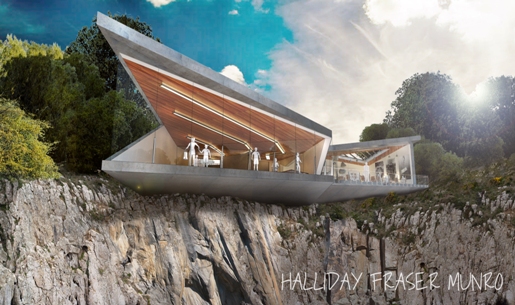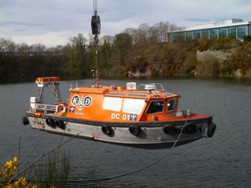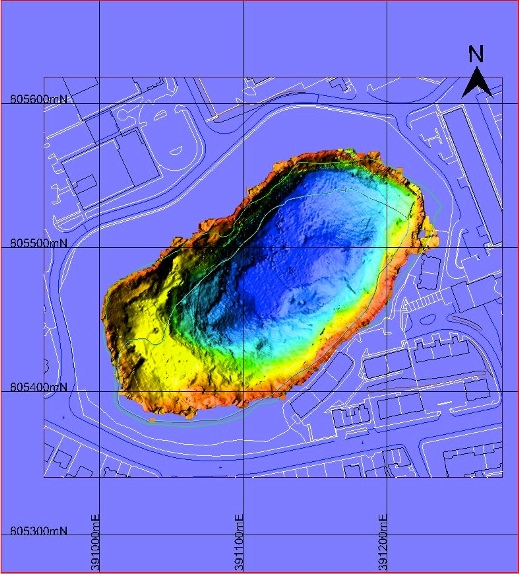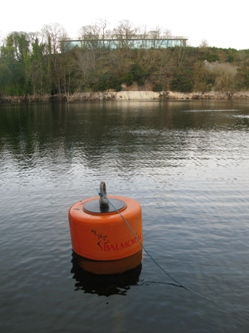Two Aberdeen lads have joined forces to put Europe’s deepest open pit back at the heart of Aberdeen’s cultural life.

“It was definitely Sandy’s fault” said Hugh.
I had just asked Sandy Whyte, a semi-retired oil consultant and Hugh Black, now retired from the construction industry, two Aberdonian lads in their 50s, how they had come to own Europe’s deepest man-made hole, the longest lived quarry in the Granite City, with a bottom below sea level and now, after 40 years of neglect, drowned beneath well over 100 metres of water. It seems that basically, they bought it because it was ‘a bargain’.
 Picture: Sandy Whyte (left) and Hugh Black on the shores of 'Rubislaw Loch'.
Picture: Sandy Whyte (left) and Hugh Black on the shores of 'Rubislaw Loch'.
Aberdeen is built from its native granite, and its walls glistered in the sunshine between showers the day I visited. Granite's near indestructibility gives Aberdeen a strangely paradoxical look of being at once ancient and yet apparently freshly minted. Gleaming Marischal College (now leased by the University to Aberdeen Council) has recently been cleaned, enhancing this impression. As we drive past it, Hugh points out that while the building interior is of Rubislaw, the famous pinnacled façade is of another famous granite, Kemnay, last used to face the Scottish Parliament buildings at Holyrood.
CITY PSYCHE
Extraction lies deep in the city’s psyche – granite from the ground, fish from the ocean, and now offshore oil and gas. But at first, Sandy and Hugh had no plan for the old quarry, and bought it purely out of sentiment. In their youth, both played in and around the dizzyingly deep hole, with its near sheer walls. Hugh recalls, with a shudder, how one of his contemporaries once clambered out along one of the steel cables slung across it, and dangled over the chasm. From these steel ropes (invented at Kemnay and named ‘Blondins’ after the French tightrope walker Charles Blondin, 1824-1897), men were lowered and granite raised. When charges were blown in the quarry floor, workers would be lifted clear - though to remove them entirely would have wasted too much time. Instead they were hoisted to an assumed safe height, protected by the steel bucket beneath them from any upwardly mobile projectiles.
Picture: Survey boat is lowered into the quarry to shoot 3D seismic.
 Some six million tonnes of Rubislaw Granite were removed during its two-century life, and you can find it all over the world: from the Forth Railway Bridge to Parliament Terrace, Westminster, to the former New York Opera House, and the Royal Insurance Building in Calcutta - making its very last public appearance in the facings of the NatWest Tower’s ground floor podium. But since closure in 1971 when pumping ceased, the quarry has been slowly filling with pure, fishless water.
Some six million tonnes of Rubislaw Granite were removed during its two-century life, and you can find it all over the world: from the Forth Railway Bridge to Parliament Terrace, Westminster, to the former New York Opera House, and the Royal Insurance Building in Calcutta - making its very last public appearance in the facings of the NatWest Tower’s ground floor podium. But since closure in 1971 when pumping ceased, the quarry has been slowly filling with pure, fishless water.
The land around the site had already been sold off. “The risky bit, the bit with all the water in it, was the last to go” says Sandy. Other buyers had expressed interest, but only Hugh and Sandy’s bid was written (it’s hard not to say it) in black and white, unencumbered by caveats over planning permission or surveys.
“We said, ‘We’ll take it, whatever’” says Black. “For a couple of Aberdeen guys to own such a huge part of the City’s history was just irresistible.” Black and Whyte bought their prize for £60,000; which considering it could swallow Edinburgh’s Castle Rock whole, conveys an amazing sense of value. Oil company offices (including Chevron, where Sandy Whyte once worked, and ConocoPhilips) and a few housing developments, peep over its rim. Otherwise, nobody would know Rubislaw Quarry was there, hidden, silent and still behind its wooded banks along affluent Queen’s Road.

Above: 3D Sonar profile of the quarry. The bottom of the pit lies below OD. During its later life, the quarry floor never received the rays of the sun.
One of the new owners’ first tasks was to install a gate, somewhere, to allow access to the water’s edge. A hole with almost sheer walls, Rubislaw has just one accessible piece of ‘coastline’, and I followed them to it through a padlocked gate, past the dissuasive notices and barbed wire that now reinforce it, over the talon-like roots of the trees binding the spoil bank, and down the other side via scrambling nets pegged to the ground.
A pontoon jetty jutted out into the still, black water, leading to a buoy from which hangs a submersible pump. Worried that the water seemed to be still rising inexorably, Sandy and Hugh decided to try to pump some of its six or seven million cubic metres away. This was partly inspired by caution over possible claims against them; but by this time a plan as to what to do with their purchase was beginning to form in their minds.
“The quarry’s been ignored for 40 years and we thought – maybe there is a chance to do something here, because if we don’t, there’s another generation gone” says Black. He and Whyte have since been vigorously interesting local children in their city’s industrial heritage and are convinced, by the overwhelmingly enthusiastic response in schools, that there is huge potential for a heritage centre to explain the Aberdeen granite industry to future generations, as well as providing a focus for tourism.
TIDEMARK
 Right: From this small buoy at the end of the pontoon jetty hangs a pump which, at the rate of 15 litres per second, lowered the lake level by the amount visible in the tidemark on the far wall in a few weeks, proving that the rate of ingress of water is manageably slow.
Right: From this small buoy at the end of the pontoon jetty hangs a pump which, at the rate of 15 litres per second, lowered the lake level by the amount visible in the tidemark on the far wall in a few weeks, proving that the rate of ingress of water is manageably slow.
Having reached the jetty I noticed there was now a grey tidemark all around the lake, much as you’d expect around a reservoir in summer, perhaps four metres broad. The trees and bushes in this zone were eerily festooned with skeins of tattered grey algae. This lowering had been the result of just a few weeks’ pumping, at a modest 15 litres per second – not enough to make any perceptible difference to the flow rate in the nearby Rubislaw Burn. In fact, barely one weekend after the pump was switched on, Hugh and Sandy could hardly believe how far the waters had receded. To their relief and satisfaction, it appeared that recharge to the quarry was manageably slow.
After spending a fun day shooting sonar from a craned-in survey boat to establish the present underwater topography (fortunately, Aberdeen is not short of such intrepid suppliers), the pair now plan to interest the universities, council and local industry in an ambitious two-stage plan to open the site to the public. Beginning with an education and heritage centre, combining industrial archaeology, ecology and geology with commercial activity (business and conference centre) to make it commercially viable, they would then look to developing the site further as an outdoor activity centre.
Chartered architects and planning consultants Halliday Fraser Munro have devised concept drawings (top) for a striking signature building, jagged as the cleaved granite itself, jutting out over the quarry - its apparent depth enhanced by further lowering the water to expose the first ledge, 30 or so metres below, and measuring about 100 by 40 metres. This would form the base for diving and climbing and any other activities. “We could even use the loch as a refugium for the Arctic Char” says Sandy. Salvelinus alpinus, a highly flavoursome relative of the salmon, is one of the rarest fish species in Britain. It is found naturally in deep, cold lakes (mostly) in Scotland, but it is currently at risk from acidification. There is no end, seemingly, to the possibilities.
Out of all the schools he has visited, Sandy recalls one in particular - Kincorth, set amid the last City council estate to be built from local stone. “We could tell the children that they could look out of any window and see - Rubislaw granite. Literally, it brought it home.” So it is that the past brings lessons for the future; the oil business, which rescued Aberdeen in the 1970s as quarrying was dying, need only peer into the depth of Rubislaw’s waters to see what one day will become of it. What will remain are the people of the Granite City, eager to keep faith with the past that made them.
Acknowledgements
Architectural drawings courtesy, Fraser Halliday Munro. 3D modelling courtesy NCS Survey. Thanks also to KD Marine, Seatronics, and James Jack Lifting Services Ltd.
Ted Nield is Editor of Geoscientist. His next book, Underlands - a personal journey through Britain’s lost landscape (or something like that) will be published by Granta later in the year.